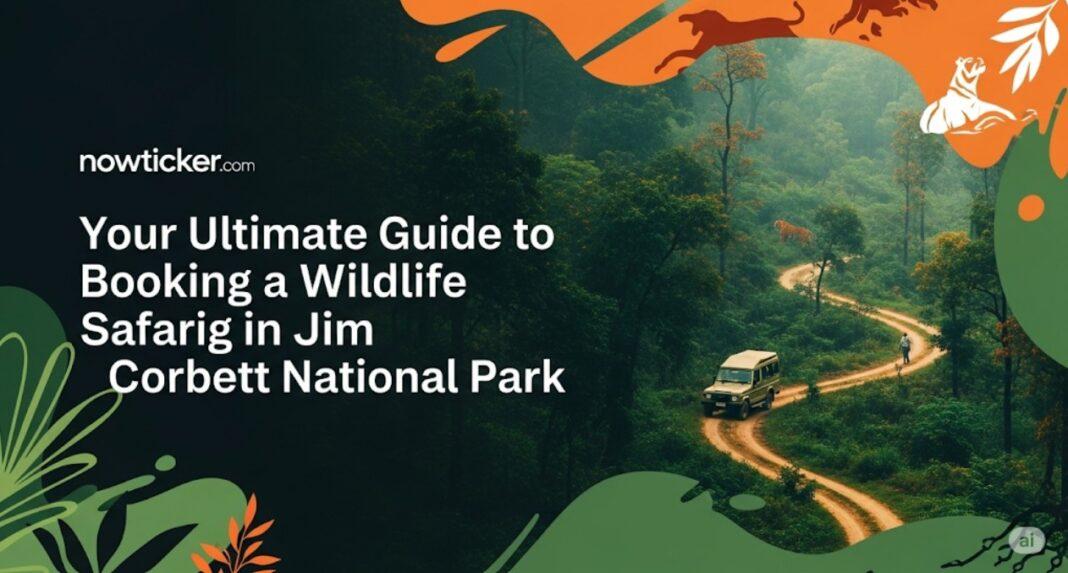Contents
Introduction
Nestled in the foothills of the Himalayas, Jim Corbett National Park is a treasure trove of biodiversity and one of the most sought-after wildlife safari destinations in India. Established in 1936, it was the first national park in India, and it serves as a sanctuary for diverse flora and fauna, including the majestic Bengal tiger. The park covers an area of approximately 520 square kilometers and features varied landscapes, from rolling hills to dense forests and riverine belts, making it a paradise for wildlife enthusiasts, photographers, and adventure seekers.
Booking a wildlife safari in Jim Corbett can be exciting yet overwhelming, particularly if you are unfamiliar with the myriad options available. This guide aims to simplify that process while offering in-depth insights, real-world experiences, and expert recommendations. Whether you’re a seasoned traveler or a first-time visitor, we will cover everything you need to know, from choosing the right safari type to practical tips that ensure a rewarding experience.
Understanding Jim Corbett National Park
Unique Ecosystem and Biodiversity
Jim Corbett is known for its rich biodiversity. The park is home to over 480 species of fauna, including mammals, birds, reptiles, and a vast variety of flora. In addition to the iconic Bengal tiger, you might encounter leopards, elephants, deer, and various species of birds ranging from the peacock to the hornbill. The park’s different zones—such as Dhikala, Bijrani, and Jhirna—offer unique ecosystems and experiences, allowing visitors to witness a range of wildlife and scenic beauty.
Real-world examples underscore the significance of the park’s conservation efforts. For instance, as of 2025, the tiger population in Jim Corbett has seen a considerable uptick, thanks to rigorous monitoring and conservation strategies led by the State Forest Department and various NGOs. This turnaround has made Jim Corbett a critical area for both biodiversity and eco-tourism.
Booking Your Safari: Types and Options
Types of Safaris
When it comes to booking a safari in Jim Corbett National Park, options abound. The park offers four primary types of safaris:
Jeep Safaris: These are the most popular and can accommodate up to six people. Jeep safaris provide visitors the flexibility to explore deeper into the park’s interior where larger vehicles can’t go. It offers a more personalized experience and is optimal for spotting wildlife.
Canter Safaris: Larger vehicles, typically open-roofed, can accommodate larger groups. These safaris focus on the Dhikala zone and allow many to experience the beauty of the park together, but they offer less flexibility compared to jeep safaris.
Elephant Safaris: For those looking for a unique experience, elephant safaris take you through dense forest areas. This type of safari can provide a closer encounter with wildlife but is limited in availability due to ethical considerations surrounding elephant rides.
- Walking Safaris: Recently introduced, these safaris offer a guided experience where trekkers can walk through designated trails, allowing for a more intimate experience with the flora and fauna. However, this option is typically available only during specific seasons and may require advanced booking.
Planning the Booking
The official website of Jim Corbett National Park provides essential information regarding bookings. When to book is crucial. Peak season runs from November to June, and booking should ideally be done 60-90 days in advance during this period.
Case Study: The Experience of Ravi Kumar
Ravi Kumar, an avid wildlife enthusiast, shares his experience in Jim Corbett. “I booked a jeep safari in the Dhikala zone during my visit in February 2025. I made my reservation through an online portal but didn’t realize I needed a valid ID for entry. Thankfully, the staff was accommodating, and they helped me in obtaining a temporary pass. The experience was unforgettable; we spotted a tiger resting beside a waterhole, a moment I’ll cherish forever.”
Preparing for Your Safari
Essential Tips and Gear
Preparation is key to maximizing your wildlife safari experience. Here are some essential tips to consider:
Opt for Early Morning Safaris: Wildlife is most active during early hours. Opting for a morning safari increases the chances of spotting animals.
Dress Appropriately: Earth-toned clothing helps blend into the surroundings. Avoid loud colors and patterns that might startle animals. Comfortable walking shoes are also a must.
Pack Essentials: Don’t forget essential items like binoculars, a good camera with a zoom lens, sunscreen, insect repellent, and water bottles. A guidebook on local wildlife can also enrich your experience.
- Follow Guidelines: Respect the park’s rules. Maintain silence, don’t feed the animals, and strictly follow your guide’s instructions.
Real User Experiences
Many travelers recommend using a reliable safari operator for a hassle-free experience. As noted by wildlife photographer Anisha Mehta, “The operator I booked with provided clear instructions on what to bring and what to expect. It set the tone for a fantastic day.”
Conservation Efforts: Engaging with the Local Community
The Role of Local Communities
Conservation at Jim Corbett National Park involves not just safeguarding wildlife but also supporting local communities. Various initiatives, such as eco-tourism projects, have been established to involve local residents in the conservation process, creating both economic opportunities and awareness about environmental issues.
For instance, eco-friendly lodges operated by local communities provide travelers with authentic experiences while supporting sustainable practices. Many travelers share their positive experiences; one user commented, “Staying at a local lodge felt rewarding. The staff not only provided excellent service, but they were also passionate about conservation. It enhanced the overall experience beyond just a safari.”
Recent Developments and Trends
Safari Technology
Technological advancements are changing the way safaris are experienced. Advanced GPS tracking systems allow rangers to monitor wildlife movements, helping safari operators better plan routes. Some organizations are even employing drones for high-res surveys of fauna, enhancing conservation strategies.
The Rise of Sustainable Tourism
As environmental awareness grows, more tourists are seeking sustainable travel options. Jim Corbett National Park is part of this trend, with a marked increase in eco-friendly lodges, restaurants supporting local produce, and educational programs.
Frequently Asked Questions (FAQs)
1. What is the best time to visit Jim Corbett National Park?
The ideal time to visit is between November and June when the weather is pleasant and wildlife spotting is optimal. The park closes during the monsoon season from mid-June to October.
2. How do I book a safari in Jim Corbett?
You can book a safari either through the official park website, authorized travel agencies, or eco-friendly lodges that offer comprehensive packages.
3. Is it safe to go on a safari in Jim Corbett?
Yes, safaris in Jim Corbett are generally safe, especially if you follow park regulations and guidelines. Rangers and trained drivers ensure visitor safety.
4. Can you see tigers in Jim Corbett?
Yes, Jim Corbett is famous for its tiger sightings, thanks to conservation efforts. The Dhikala zone is particularly noted for this.
5. What are the accommodation options near the park?
From luxury resorts to budget-friendly lodges and eco-stays, there are numerous options, catering to various preferences and budgets.
Conclusion
Booking a wildlife safari in Jim Corbett National Park is not just about observing animals; it is about immersing yourself in nature and contributing to conservation. As you plan your adventure, remember that preparation, respect for the environment, and engagement with local communities significantly enhance the experience. As wildlife tourism continues to thrive, the responsibility lies on visitors to ensure their footprint is light while supporting ongoing conservation efforts.
Engage in your own adventure and perhaps discover a new passion for wildlife and conservation. Those who embark on this journey will not only witness breathtaking vistas and magnificent wildlife but also be part of an ongoing narrative that values and protects the Earth’s natural heritage. Your adventure awaits; all you need to do is take that first step. Are you ready?



